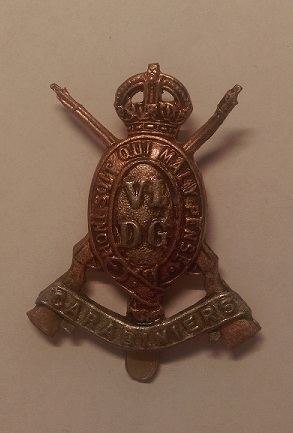Active 1685-1922 Type Line Cavalry | Branch Army Role Cavalry | |
 | ||
Country Kingdom of England (1685–1707) Kingdom of Great Britain (1707–1746, 1788–1800) Kingdom of Ireland (1746–1788) United Kingdom (1801–1922) | ||
The Carabiniers (6th Dragoon Guards) was a cavalry regiment of the British Army. It was formed in 1685 as the Lord Lumley's Regiment of Horse. It was renamed as His Majesty's 1st Regiment of Carabiniers in 1740, the 3rd Regiment of Horse (Carabiniers) in 1756 and the 6th Regiment of Dragoon Guards in 1788. After two centuries of service, including the First World War, the regiment was amalgamated with the 3rd Dragoon Guards (Prince of Wales's) to form the 3rd/6th Dragoon Guards in 1922.
Contents
- History
- Battle honours
- Colonels
- 1685 The Queen Dowagers Regiment of Horse
- 1692 The Kings Regiment of Carabineers
- 1740 His Majestys 1st Regiment of Carabiniers
- 1756 3rd Regiment of Horse Carabiniers
- 1788 6th Regiment of Dragoon Guards
- 1826 6th Regiment of Dragoon Guards Carabineers
- Uniforms and Insignia
- References
History
The regiment was first raised by Richard Lumley, 1st Earl of Scarbrough as the Lord Lumley's Regiment of Horse in 1685, as part of the response to the Monmouth Rebellion by the regimenting of various independent troops, and was ranked as the 9th Regiment of Horse. Shortly thereafter, Lumley petitioned the Queen Dowager to permit labeling the regiment The Queen Dowager's Horse, which request was granted. In 1690 it was re-ranked as the 8th Regiment of Horse and, after distinguishing itself during the Williamite War in Ireland and in Flanders during the Nine Years' War, it was renamed The King's Regiment of Carabineers in 1692. The regiment was ranked as the 7th Horse in 1694 and it fought at the Battle of Blenheim in August 1704 and the Battle of Ramillies in May 1706 during the War of the Spanish Succession.
The regiment was renamed the His Majesty's 1st Regiment of Carabiniers in 1740 and it took part in the response to the Jacobite rising in 1745. It was the transferred to the Irish establishment in 1746 and re-ranked as the 3rd Horse. It was next re-designated the 3rd Regiment of Horse (Carabiniers) in 1756 and then transferred back to the British establishment as the 6th Regiment of Dragoon Guards in 1788. It saw action in Flanders again in 1793 during the French Revolutionary Wars. It then became the 6th Regiment of Dragoon Guards (Carabineers) in 1826. It saw action at the Siege of Sevastopol during the Crimean War and was deployed to Afghanistan in the late 1870s during the Second Anglo-Afghan War. The regiment also took part in the relief of Kimberley in February 1900 during the Second Boer War.
In 1906, the regiment took part in the parade at the Grand Durbar (the visit of the Prince and Princess of Wales to Bangalore). It landed in France at the outbreak of the First World War as part of the 4th Cavalry Brigade in the 1st Cavalry Division on 16 August 1914 for service on the Western Front. It took part in the Battle of Mons in August 1914, the First Battle of the Marne in September 1914, the First Battle of Ypres in October 1914 and the Second Battle of Ypres in April 1915 before going on to see further action at the Battle of the Somme in Autumn 1916, the Battle of Arras in April 1917 and the Battle of Cambrai in November 1917.
In October 1922, the regiment was amalgamated with the 3rd Dragoon Guards (Prince of Wales's) to form the 3rd/6th Dragoon Guards.
Battle honours
The regiment's battle honours were as follows:
Colonels
The regiment's colonels were as follows:
1685 The Queen Dowager's Regiment of Horse
1692 The King's Regiment of Carabineers
1740 His Majesty's 1st Regiment of Carabiniers
1756 3rd Regiment of Horse (Carabiniers)
1788 6th Regiment of Dragoon Guards
1826 6th Regiment of Dragoon Guards (Carabineers)
Uniforms and Insignia
The original uniform of the Queen Dowager's Regiment of Horse is recorded as including a red coat lined with green. In common with other regiments of Horse, cuirasses were worn until 1699. In 1715 the regimental facing colour was changed to pale yellow. In 1768 white lapels were adopted by Royal Warrant. Silver epaulettes were worn by the officers. In 1812 a new model of leather helmet was issued, carrying the title of "6th Dragoon Guards or Carabiniers". In 1861 a complete change of uniform was authorized by Queen Victoria, following the conversion of the regiment to a light cavalry role and appearance. Thereafter until 1914 the full dress of the regiment was entirely dark blue with white facings. Although the designation of Dragoon Guards was retained, the 6th was the only dragoon regiment in the British Army to wear dark blue tunics instead of scarlet. After 1873, a white plume was worn on the bronze helmet.
The distinctive feature of the collar and cap badges as worn from 1900 and 1902 respectively, was the appearance of crossed carbines under a crown and above the regimental title.
